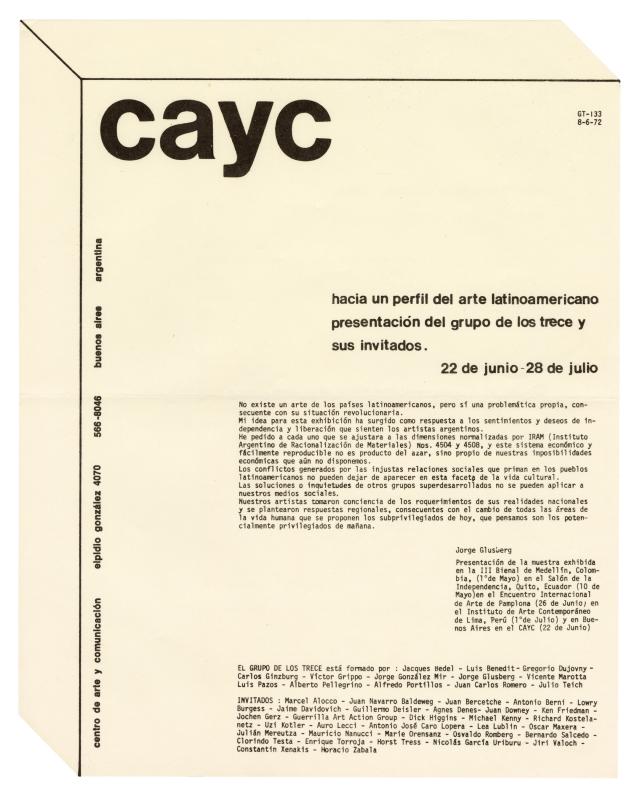Ever since it was founded, the CAYC (Centro de Arte y Comunicación), helmed by the cultural promoter, artist, and businessman Jorge Glusberg, was intended as an interdisciplinary space where an experimental art movement could flourish. The establishment of collaborative networks connecting local and international artists and critics played a key role in this process. The exhibitions shone a light on these exchanges, in which overviews of trends or individual artists introduced the innovations of international contemporary art and made Argentine and Latin American artists better known on the global scene.
Hacia un perfil… showed works in which Argentinean and international artists pondered the political situation that was common to all their countries. The exhibition provided a perspective on art and the Grupo de los Trece’s ideology in a concise overview of contemporary regional art. The CAYC’s version of arte de sistemas not only referred to international process art; its political stance, absorbed during its many productions, gave it an identity of its own and associated it with a regional identity. In his introduction to the exhibition, Glusberg said: “There is no Latin American art as such, but the region’s individual countries do share a common problem in terms of their revolutionary situation” [GT-133 (doc. no. 1476312)]
The exhibition’s travels, mentioned in this newsletter, shed some light on the radical change of direction that was taking place at the CAYC and the new phase in its close relationships with critics, cultural promoters, institutions, and art circuits in different parts of Europe (Germany, England, and France) and North America.
The eagerness to create links between Latin American and Eastern European art was a fundamental, if somewhat politicized, aspect of the CAYC’s strategy for international exchange. The center advocated a “unity of strengths” among national art scenes in what were considered Third World countries. Glusberg saw the result as a form of art that was involved in the world scene while still reflecting the specific local problems the individual countries had in common. The organization of this exhibition with the support of the Polish embassy in Argentina can be seen as a determined effort to strengthen ties that were of particular significance during the time of the Cold War. The Theory of Dependence was being circulated in Latin America at that time, which explained that the poverty the region’s countries were experiencing was a consequence of the imperial oppression imposed by the great world powers.
Among other events, the center promoted: Computer Art in Zagreb [GT-240 (doc. no. 1476436)] in what was then Yugoslavia, but is now Croatia; Fotografía polaca on several occasions [de GT-100 (doc. no. 1476356) a GT-106 (doc. no. 1476373); Czechoslovakian prints at the Narodni Galerie in Prague [GT-121 (doc. no. 1476407) y GT-122 (doc. no. 1476408)], and Argentinos en Checoeslovaquia [GT-26 (doc. no. 1476283)].






